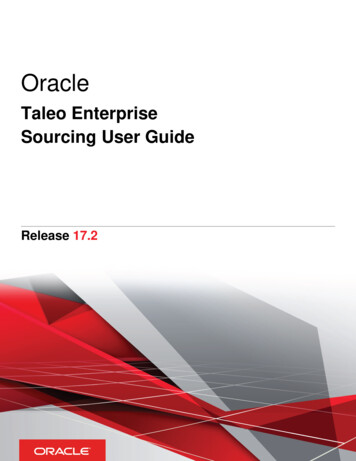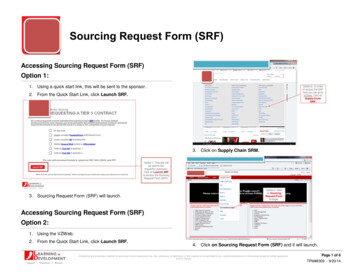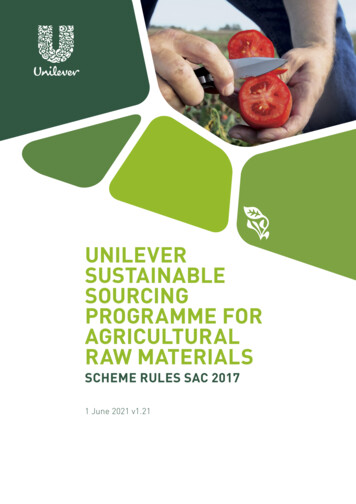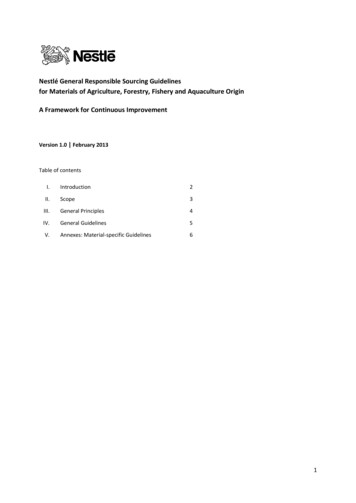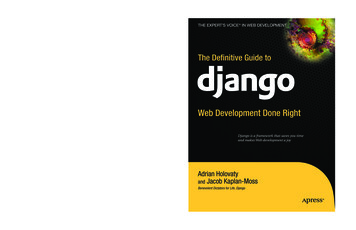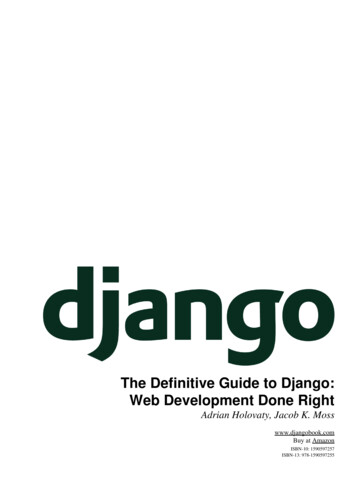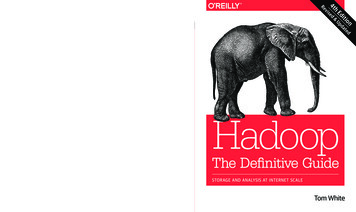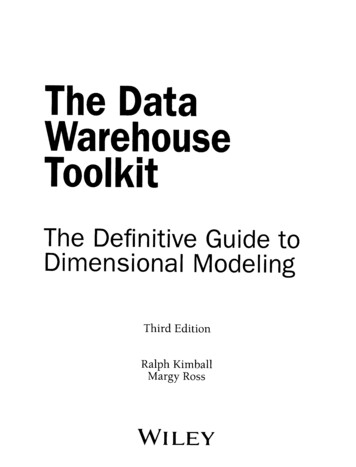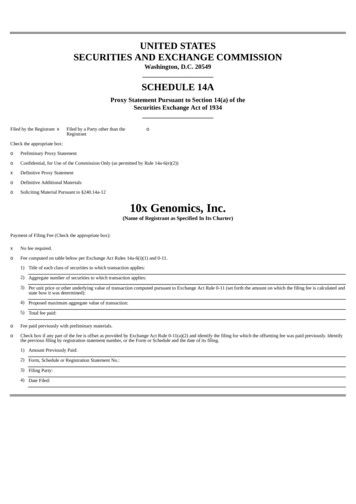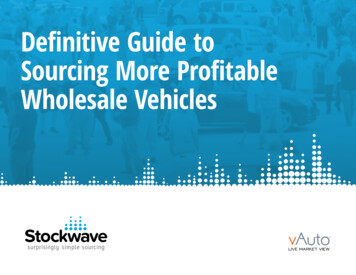
Transcription
Definitive Guide toSourcing More ProfitableWholesale Vehicles
Introduction from vAuto Founder Dale PollakThank you for your interest in becoming a better, more profitable auction buyer. The fact thatyou’re seeking new insights to improve your wholesale sourcing efforts puts you ahead of otherdealers who are content to do what they’ve always done at auctions and hope forbetter results.As your recent auction experience likely attests, the wholesale marketplace is much differenttoday. True, the physical auctions still function the same way — dealers arrive early to size upthe merchandise, the cars move down the lanes and hit the block, the auctioneer starts to riff,your heart rate rises, and the bidding begins.“In short, there’s been a steady shift toward efficient, smart and sophisticated auction-buying inrecent years, due in no small part to increased competition among franchise and independentdealers to get the cars today’s customers want to buy. You could say that while the nature ofthe auction game hasn’t changed, the way you play the game has changed significantly.“Dale PollakFounder, vAutoBut if you look a little closer, there are key differences. Today’s auction buyers, whether inthe lane physically or online, increasingly come armed with technology — mobile devices thathelp them build a specific buy list, evaluate the cars they know they need and may want topurchase, create bidding strategies for each unit, track available units across multiple lanes,and understand each unit’s retail profit potential every time the gavel goes their way.You could say that while the nature of theauction game hasn’t changed, the way youplay the game has changed significantly.That’s the purpose of this ebook — to offer you insights into the waystop-performing franchise and independent dealers have changed the waythey source wholesale vehicles. In the following pages, you’ll discover fivebest practices to become a more effective and efficient buyer, and makemore money than you used to on auction-purchased inventory.Thank you again for being a student of the business and taking time to sharpen your wholesalesourcing game plan.— Dale Pollak
Best Practice1Know the Cars You Need, with Specificity“A lot of dealers look at their inventories and say, ‘I’m used to selling this many cars, so I needthis many cars.’ They don’t pay as much attention as they should to the specific vehicles theyreally need for their inventories and markets. We’re a lot more disciplined. We know the colors,equipment and mileage that matter most for specific makes / models / model years, and how longit’ll take us to retail the unit if we acquire it. We’re very purposeful and laser-focused on potentialprofit. We believe our process provides competitive advantage.”This comment comes from the used vehicle manager for a Penske Automotive store in theSouthwest. It illustrates what could be described as rising reliance on market-based dataand science among dealers to guide their wholesale sourcing efforts.More and more, dealers don’t simply trust the instincts of a longtime buyer or manager,particularly when their desire to grow their used vehicle sales volumes necessitates takingtheir inventory beyond the handful of makes and models that traditionally perform well.
Best Practice“These dealers and used vehicle managers typically invest in technology to help themidentify the wholesale vehicles that make the most positive, profit-based impact on theirdealerships. The tools deliver personalized streams of available inventory and providethree important insights about any wholesale vehicle:1. The right characteristics: Nuance matters in today’s market, especially wheninternet-enabled buyers can easily compare cars and know if your car is really asdistinct and special as you may claim it to be. The best tools allow you to make carto-car competitive comparisons to understand whether color, condition, equipment,mileage, age or price will move the needle at retail in your market. Armed with theseinsights, dealers typically make fewer purchases for the wrong vehicles.2. The retail turn time: Dealers have come to rely on assessing each vehicle’s marketdays supply metric to understand, right up front, how a potential auction vehiclewill fare in their market due to competing units. This metric measures the relativesupply/demand data for specific vehicles in a given market — the higher the number,“1Know the Cars You Need, with Specificity (cont.)I know I’ll make a little less on thefront end, but I’ll sell the car quicklyand pick up back-end and servicegross. I’ll take that deal all day long.the longer it can take to sell the vehicle.Sometimes, if the market days supply is attractive enough, the dealers knowa vehicle merits paying a little more than they might prefer to acquire it.“I’ll pay extra for a vehicle with a market days supply below 70,” says theused vehicle director at a three-store group in the Midwest. “I know I’ll makea little less on the front end, but I’ll sell the car quickly and pick up back-endand service gross. I’ll take that deal all day long.”A recent study of top-performing dealers across the country shows that they averagea market days supply of 69 for their overall inventories.
Best Practice1Know the Cars You Need, with Specificity (cont.)3. Vehicle financials: It’s increasingly common for dealers to use a “retail-back”approach to determine how much they can pay for a particular auction vehicle. Thatis, they’ll assess the current retail market, the competing cars and prevailing retailprices, and then subtract their expected gross profit and related costs (e.g., buy fees,recondition, packs, transportation, etc.) to figure out how much they can pay and thepotential profit.Industry experts recommend that dealers strive to acquire wholesale inventory with a cost-tomarket metric of 84 percent. This benchmark allows a 16 percent spread between theacquisition costs and prevailing retail prices.The best wholesale sourcing tools do the cost-to-market calculations instantly for everyvehicle, giving dealers an immediate view of the opportunity and risk inherent in any carbefore auction bidding begins.
2Best PracticeExpand Your Reach; Reap the RewardsAn independent dealer outside Minneapolis recently shared that he’s cut his acquisitioncosts for cars at auction by about 10 percent in the past six months.How? The dealer looks for specific units across a wider network of auction sources.“In the past, I never really looked beyond our local auctions,” says the dealer, who retailsabout 80 units a month.But, with the help of technology that shows him available vehicles across the country, he’snow buying vehicles from auctions he never previously considered.“I bought a minivan from Phoenix the other day for 15 percent less than I could haveacquired it here, even with transportation,”he says. “I used to think I didn’t need to goHow has your auction sourcing processbeyond my backyard, until I saw the cars.”changed in the last 12–18 months?This example illustrates that reach bringsrichness when it comes to wholesale sourcing.A recent survey asked 100 franchise andindependent dealers how they’ve changed theway they source vehicles at auction.The findings (see box, this page) suggest that15%31%26%28%We’re going to moreauctions than we used to.We’re buying a few morecars online than we used to.We don’t go to physicalauctions; we only buy online.Our process hasn’t changed.an increasing number of dealers recognizethat the local auctions they know and trust aren’t as productive or profitable as they usedto be — and that online auctions offer the most efficient means to expand your wholesalesourcing reach and rewards.
ceBe s t P r a c t i““I get so impatient and tired of losing cars, I just buy them.”So goes the reaction of many dealers and used vehicle managers to today’s auction-buyingexperience. It’s symptomatic of the increased competition in the lanes and online. It’s also aframe of mind that often results in over-paying for auction vehicles.The key? Sticking to your game plan, even if it causes anxiety and heartburn. The fact is, usedvehicle margins in today’s market are too thin for you to let emotions cloud a goodinvestment decision.An independent dealer in Texas proactively primes his buyers to view losing cars toother bidders as part and parcel of what it means to be a better auction buyer in today’smarket — an approach you could call “failure-focused auction acquisitions.”The dealer says, “Our motto is we need to look at four times the average amount ofinventory other buyers will look at every day. We have to appraise three times as manyvehicles as the average buyer, and we have to be unsuccessful at a three-times-greater rate.When we do this consistently, we’ve looked at quadruple the amount of cars and triple the“3Buy with Discipline, Not Regretnumber of appraisals, and we get the inventory we need.”The dealer uses sourcing tools to “make my buyers more and more efficient so that theyThe fact is, used vehicle margins in today’smarket are too thin for you to let emotionscloud a good investment decision.can do this every day and not kill themselves. The ultimategoal is that they spend their time not in searching for cars, butbecoming the best buyers, so that when they know the right carand the right price, and where it’s located, they can get the car.”
Best Practice4Hold Buyers AccountableDealers are increasingly linking compensation for used vehicle buyers to the actual retailperformance of the vehicles they acquire from auctions.The compensation plans typically incorporate one or both of the following features:1. Accountability to purchase parameters: Dealers use technology / tools to setminimum expectations for purchasing vehicles within the cost to market, front-endgross profit objective and other parameters they build into their auction purchasebusiness plans. The buyers might receive a maximum bonus if their purchases reflectthe parameters 95 percent of the time or more, with smaller, tiered bonus amountspaid when purchase histories reflect a lower rate of purchase parameter compliance.2. Days to sale: Some dealers reward buyers when auction-purchased vehicles retailwithin the timelines they set for purchased units. Such bonus payments typicallyinspire collaboration between buyers and in-store managers to ensure pricingdecisions strike a balance between meeting grossprofit and inventory turn objectives.
ice5Be s t P r a c tProtect and Manage Your InvestmentThere is always a risk involved in acquiring a vehicle at auction. Maybe you missed a flawduring your appraisal. Maybe the condition report lacked the accuracy you expect. Maybeyour buyer bought the wrong car, or the right car with the wrong color or equipment.Whatever the case, today’s wholesale environment offers dealers options to mitigate therisk of buying vehicles from auctions. These include:No-risk buying: Vendors like DealShield offer guarantees that give dealers the ability toreturn vehicles that don’t meet their expectations or perform as expected.Arbitration: All auctions offer some type of arbitration to address problems with auctionpurchased vehicles. Dealers say these services have improved over the years, as auctionsincreasingly focus on dealer purchase loyalty and preference.Such services can help dealers minimize the number of problem cars entering theirinventory. But once you own the car, it’s your job to protect the investment.
iceBe s t P r a c t“An industry study of more than 7,000 dealer inventories shows that up to 70 percent ofaged units (defined as vehicles more than 60 days old) started as auction purchases. Thisfinding suggests that dealers could do a better job of treating auction purchases as whatthey are — an investment that’s generally more costly and risky than vehicles you take in ontrade or get through other sources.The most profitable dealers meet this challenge by creating pricing strategies that applyto auction purchases. Generally, these pricing strategies result in more competitive pricepositions from Day One, to help drive a faster retail sale and mitigate the risk of marketexposure / volatility for their investment. In addition, some dealers apply a separateinventory turn benchmark to auction vehicles, striving to retail these vehicles within 30 daysto maximize their profitability.“5Protect and Manage Your Investment (cont.)Generally, these pricing strategies result in morecompetitive price positions from Day One, to helpdrive a faster retail sale and mitigate the risk ofmarket exposure / volatility for their investment.
Quick Summary on Sourcing MoreProfitable Wholesale Vehicles1. Know the Cars You Need, with Specificity2. Expand Your Reach; Reap the Rewards3. Buy with Discipline, Not Regret4. Hold Buyers Accountable5. Protect and Manage Your Investmentstockwave.com 888-365-1032
top-performing franchise and independent dealers have changed the way they source wholesale vehicles. In the following pages, you’ll discover five . mo
